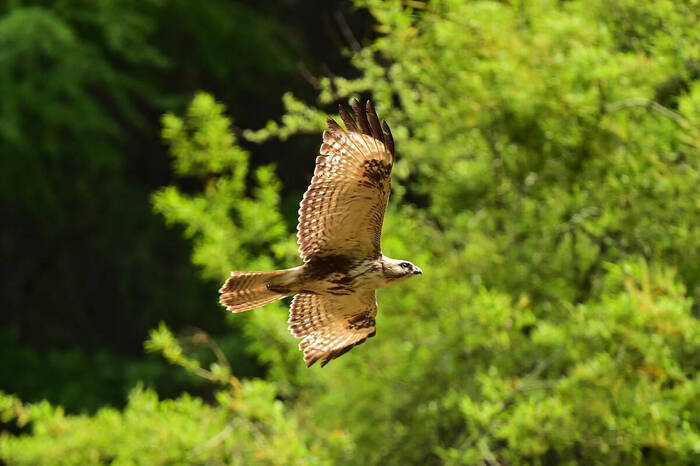Buteo refectus
IUCN
LCBasic Information
Scientific classification
- name:Buteo refectus
- Scientific Name:Buteo refectus,Himalayan Buzzard,Buteo buteo burmanicus Hume, 1875,Buteo japonicus refectus Portenko, 1935,Buteo refectus Portenko, 1935,Buteo buteo refectus Portenko, 1935
- Outline:Raptor
- Family:Falconiformes Accipitridae Buteo
Vital signs
- length:45-53cm
- Weight:575-1073g
- lifetime:20-40years
Feature
The position of the nostrils is parallel to the mouth.
Distribution and Habitat
Origin: China, India, Nepal and Pakistan; non-breeding area: Bhutan.
During the breeding period, it mainly inhabits mountain forests and forest edges, from the broad-leaved forest at the foot of the mountain at 400 meters to the mixed forest and coniferous forest at 2000 meters. Sometimes it even appears above the mountaintop tundra zone above 2500 meters above sea level. In autumn and winter, it mostly appears in low mountains and hills and plains at the foot of the mountain.
Appearance
Body length 45-53 cm, wingspan 112-118 cm. Weight 575-1073 grams. The upper body is dark reddish brown; the skin on the side of the face is yellow with almost red fine lines, and the chestnut mustache pattern is obvious; the lower body is mainly dark brown or light brown, with dark brown horizontal spots or vertical stripes, and the tail feathers are light grayish brown with multiple dark lines. Horizontal spots, the wings are broad when flying, there are obvious white spots at the base of the primary flight feathers, the underwings are flesh-colored, only the wing tips, wing angles and outer edges of the flight feathers are black (light type) or all are dark brown (dark type) , the tail feathers fan out. When soaring at high altitude, the wings form a slight "V" shape. In addition, the position of its nostrils is parallel to the rostrum, while the nostrils of other buzzards are at an oblique angle to the rostrum. The iris is yellow to brown; the beak is gray, the tip is blac
Details
Himalayan Buzzard, also known as Himalayan Buzzard in English, is a medium-sized bird of prey with no subspecies.

The scientific name of the Himalayan buzzard is (Buteo refectus), which was once included in the Eurasian buzzard (Buteo buteo). In 2014, it was separated from the Eurasian buzzard and became an independent species.
The Himalayan buzzard is commonly seen hovering and soaring over open plains, deserts, wilderness, cultivated areas, forest edge grasslands and villages. It usually moves alone, but sometimes 2-4 are seen hovering in the sky. It is active mainly during the day. It is alert and has sharp vision. It is good at flying, and spends most of the day hovering and gliding in the air, with its broad wings spread out to the left and right, and slightly raised upwards to form a shallow "V" shape, and its short and round tail spread out in a "fan" shape, with an extremely graceful posture. Its call is a loud meow, peeioo.
The Himalayan buzzard feeds on forest rodents. In addition to rodents, it also eats frogs, lizards, snakes, hares, small birds and large insects. Sometimes it also goes to villages to prey on poultry such as chickens. The main hunting method is to fly in circles in the air, observe and search with sharp eyes, and once the prey on the ground is found, it suddenly dives down quickly and grabs it with its claws. In addition, it also perches on high places such as branches or electric poles to wait for prey, and only pounces when the prey appears in front of it.
The breeding season of the mountain buzzard is from May to July. It usually nests on the edge of the forest or on tall trees in the forest, especially coniferous trees. It usually nests on branches near the main trunk in the upper part of the tree canopy, 7-15 meters above the ground. There are also nests on hanging rocks, and sometimes they also invade crow nests. The nest structure is relatively simple, mainly made of dead branches, padded with pine needles, twigs and dead leaves, and sometimes feathers and animal hair. The size of the nest is 60-90 cm in outer diameter, 20-30 cm in inner diameter, 40-60 cm in height and 10 cm in depth. Eggs are laid in May-June, with 2-3 eggs per nest, occasionally up to 6 eggs and as few as 1 egg. The eggs are bluish-white with chestnut brown and purple-brown spots and stripes, and are 50-61 mm × 41-48 mm in size. After the first egg is laid, incubation begins, and the male and female parents share the responsibility, with the female being the main incubator. The incubation period is about 28 days. The chicks are late-maturing, and after hatching, they are fed by the male and female parents. After 40-45 days of nesting, the chicks can fly and leave the nest.
Due to the uncertainty of the impact of habitat transformation on the number of Himalayan buzzards, it is difficult to determine the number trend.
Listed in the IUCN Red List of Threatened Species in 2016 ver3.1 - Least Concern (LC).
Listed in Appendix I, II and III of the Convention on International Trade in Endangered Species of Wild Fauna and Flora (CITES) 2019 edition Appendix II.
Listed in China's National Key Protected Wildlife List (February 5, 2021) Level II.
Protect wild animals and stop eating game.
Maintaining ecological balance is everyone's responsibility!








